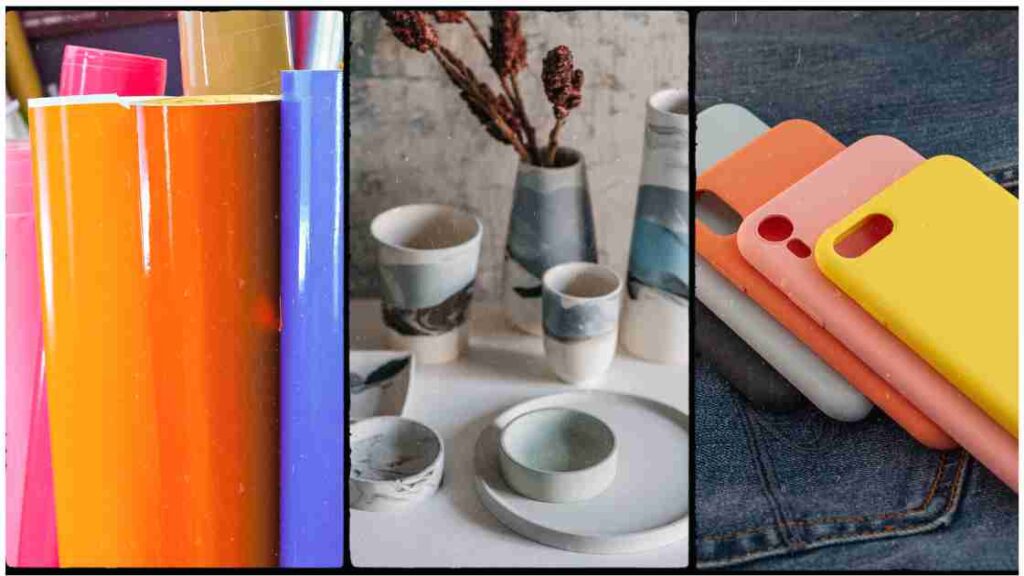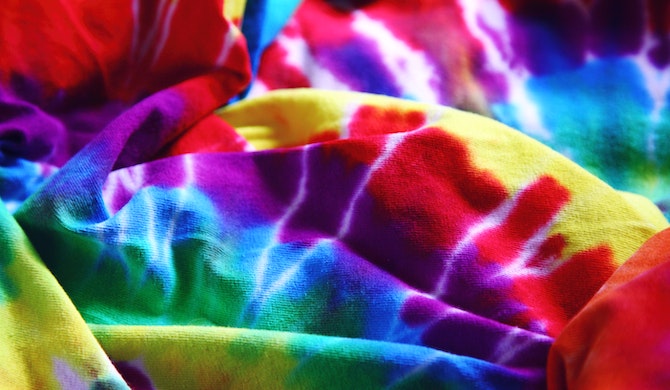Choosing the correct material is crucial for a successful sublimation process.
We will discuss the various substrates that can be used for sublimation, as well as the characteristics that make each substrate particularly well-suited to this technique.
We will talk about the different possibilities and strategies for getting the greatest outcomes answer you query “What Material Can You Sublimate on?” ranging from polyester textiles to ceramic mugs and metal keychains.
What Material Can you Sublimate on ?

Several common materials that you can sublimate on :
- Polyester
- Nylon
- Ceramic
- Metal
- Coated metal
- Cell phone cases
- Mugs
- Tiles
- Keychains
- Plates
- Mouse pads
- Apparel fabrics like sportswear and performance wear
- Umbrellas
- Flags
- Beanie
- Tote bags
- Pillow covers
- Awards and Trophies
Sublimation is possible on a wide variety of materials, including those listed above, albeit the challenge increases with the complexity of the material.
Unless the material is polyester, which fits all the parameters for sublimation, you should learn as much as possible about it before beginning any project that requires sublimation.
It’s possible that some patterns may need a particular ink or a solution in order to stick, or that they’ll need a different kind of coating in order to produce the desired outcomes.
Therefore, it is usually recommended that you know what you’re doing.
Related: Can You sublimate on Nylon ?
Can you sublimate on neoprene?
Neoprene is a type of man-made rubber that is known for being flexible, durable, and water-resistant.
It is often used to make wetsuits, laptop sleeves, and other things that keep you safe.
People often wonder if they can use sublimation printing on neoprene because of its unique properties.
But not all materials can be printed on with sublimation, and one of them is neoprene.
Neoprene can’t be sublimated because it is made of natural rubber and not a synthetic polymer.
It also doesn’t have a polyester coating, which is needed for the sublimation process to work.
In order for the ink to be absorbed properly during the sublimation process, the material must have a certain coating. Neoprene does not have this coating.
Also Read: Can You Sublimate on Plastic ?
Can you Sublimate on dark colors?

When sublimating on dark colours, the process is a little more difficult.
Since the ink is clear, it can be hard to get a good print on dark fabrics or other materials that can be seen.
But there are a few ways to deal with this problem. There are some methods that can be used to sublimate on dark colors.
Required material:
- Dark colored fabric ( with polyester coating)
- Dye sublimation ink ( For Dye Sublimation Method)
- Transfer paper
- Sublimation printer
- Heat press
- Protective cover sheet
- Sublimation Blocker (For sublimation Blocker Method)
Method 1. Using sublimation blocker
Use a “sublimation blocker” or “sublimation underbase” as one option. Before the design or image is printed, this white ink is put on the dark material.
The blocker acts as a barrier between the dark material and the sublimation ink, which lets the colours show up more clearly.
- Prepare the material: Make sure the fabric is clean, dry, and doesn’t have any wrinkles in it. Also, you should test the fabric first to make sure it can be used for sublimation printing.
- Apply the sublimation blocker: Put the sublimation blocker on the spot where you want the design to be printed. This makes a barrier that stops the sublimation ink from going through the fabric fibres. Let the sublimation blocker dry all the way out.
- Print the design: Print the design on sublimation paper with a sublimation printer and sublimation ink.
- Heat press the design: Place the printed design on the material, with the printed side facing the material. Use a heat press to transfer the design onto the material. The temperature and pressure settings will depend on the type of material being used but the reccommended is 400 degree (fahrenhiet).
- Peel off the paper: Take the transfer paper off the fabric and wait for it to cool. Your picture or design should now be printed in a way that won’t come off on the dark material.
Popular: Can you Sublimate on leather ? Best Guide (2023)
Methods 2. By Dye Sublimation
Another option is to use a process called “dye sublimation” which uses a different kind of ink that is made to work on dark materials.
This ink can stick to the fibres of the material, making a print that is more vivid and lasts longer.
- Start by choosing a material that can be sublimated and is dark. Polyester fabrics, ceramic mugs, and metal keychains are all popular choices.You will need to buy dye sublimation ink and transfer paper that is made to work on dark materials.
- Use a graphics editing programme to make your design or image, and then use a sublimation printer to print it on the transfer paper.
- Set the heat press to the right temperature for your material and turn it on (usually around 400 degrees Fahrenheit).
- Make sure the transfer paper is straight when you put it on the dark fabric.
- Put a protective cover sheet over the transfer paper and the material, and then use the heat press to press them together. Most of the time, this is between 60 and 90 seconds.
- Take off the transfer paper and wait for the fabric to cool. Your picture or design should now be printed on the dark material in a way that won’t come off.
Can you sublimate on 100% Cotton ?

Sublimation printing can’t be done on 100% cotton because the standard sublimation process needs a polymer coating on the fabric’s surface.
This lets the sublimation ink turn into a gas and get into the fabric’s fibres. Cotton doesn’t have this polymer coating, so the sublimation ink can’t stick to it.
But luckily, there are a few ways to do sublimation on cotton and some rules that go along with these ways.
One thing to keep in mind when sublimating on 100% cotton is that the cotton must be white or light-colored, as the sublimation ink will not show up on darker fabrics.
Additionally, it is important to preheat your heat press to the appropriate temperature for sublimation on cotton before you begin the process.
This will ensure that the ink is fully absorbed into the fibers and that your designs look crisp and vibrant.
You May Like: Can you Sublimate on Glass ? Step-By-Step Guide (2023)
Method 1: Using a sublimation transfer paper
- Start by getting your cotton fabric ready to use. This will help get rid of any moisture and wrinkles, making the transfer go more smoothly and evenly.
- Next, use a sublimation printer to print your design on sublimation transfer paper. Make sure the design is printed backwards. During the transfer process, the design will be flipped back to the right way.
- Cut out your design and place it on the cotton fabric that has already been heated.
- Place the transfer paper and cotton fabric in a heat press and press according to the instructions on the package of transfer paper. Most of the time, you will need to press at a high temperature (around 400 degrees Fahrenheit) for about 15-20 seconds.
- Once the time is up, carefully peel the transfer paper off the cotton fabric.
- Your design should now be on the cotton fabric in its original form.
Additional tips:
- Find the optimal press time and temperature for your transfer paper and cotton fabric by trying out various combinations.
- Try stacking several transfers for a more colourful and long-lasting end result.
Method 2: Using sublimation adhesive vinyl
- Start by using a vinyl cutter or scissors to cut out your design from sublimation adhesive vinyl.
- Peel off the paper backing from the vinyl and place it on the cotton fabric.
- Use a tool for applying vinyl to smooth out any bubbles or wrinkles.
- Put the cotton fabric and vinyl in a heat press and press according to the instructions on the vinyl package. The heat press time will be same as the last method ( 400 degree fahrenhiet for 15 to 20 seconds ).
- Once the time is up, carefully peel the vinyl off the cotton fabric.
- Now, all of your design should be on the cotton fabric.
Additional tips:
- Make sure the adhesive vinyl is put on the cotton fabric as smoothly as possible for a smooth and even transfer.
- Try using a tool for applying vinyl to smooth out any bubbles or wrinkles.
- Use an adhesive vinyl made for fabrics if you want to add texture to your design.
Related Post: Can You Sublimate on Rayon? (6 Easy Steps)
Method 3: Using a sublimation coating
- Start by getting your cotton fabric ready to use.
- Use a brush, roller, or spray bottle to put a high-quality sublimation coating on the cotton fabric. Make sure that the coating is put on the fabric in an even way.
- Using a sublimation printer, you can print your design on sublimation transfer paper. Make sure the design is printed backwards. During the transfer process, the design will be flipped back to the right way.
- Cut out your design and place it on the cotton fabric that has been coated.
- Place the cotton fabric and transfer paper in a heat press and press according to the instructions on the coating package. Press both for (around 400 degrees Fahrenheit) for about 15-20 seconds.
- Once the time is up, carefully peel the transfer paper off the cotton fabric. Check the design for any mistakes or cracking. If there isn’t any you’re good to go.
Additional tips:
- Use a high quality sublimation coating to get better results.
Remember that the design won’t be as vivid or long-lasting as it would be with a conventional sublimation procedure.
All of these fabrics mentioned above are not suitable for sublimation but under these conditions you might be able to get results but not as good as the original sublimation procedure.
Read the product’s instructions carefully and perform a trial run on a scrap of the material before committing to the full scale production.
Frequently Asked Questions
Q: Is sublimation printing suitable for all types of fabrics?
Not all fabrics are suitable for sublimation printing.
Natural fabrics such as cotton, linen, and silk are not suitable for sublimation, as the process requires high heat, which can damage these types of fabrics.
Synthetic fabrics, such as polyester and nylon, are more suitable for sublimation printing.
Q: Can sublimation be used on leather items?
Sublimation is not typically used on leather items as the process requires high heat, which can damage the leather.
It’s better to look for alternative printing methods like screen printing or heat press.
Q: Can you sublimate on metal?
Yes, you can sublimate on metal. Metal items that have been coated with a special sublimation coating can be used with sublimation printing.
It’s important to ensure that the metal you are using is sublimation-compatible, as not all types of metal are suitable for the process.
Conclusion
In conclusion, a broad variety of substrates are suitable for the sublimation printing process.
These include polyester, polyester-coated goods, ceramics, metal, and plastics.
You should check if the material you wish to print on is compatible with the sublimation process, as not all materials are suited for it.
Neoprene with a polyester coating can also be processed in this manner. Furthermore, sublimation is not applicable to all metals.
To sum up, before deciding to use sublimation as a printing method, it is crucial to think about the material and its compatibility.





